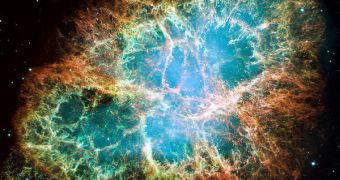Stellar explosion are cosmic events of unimaginable magnitude. Seen from light-years away, they look amazing, with streams of particles being emitted everywhere around, and with remnants coloring the darkness of space. But close-by, the effects of the blast aren't nearly as pleasant, as everything around the dying star is destroyed. Researchers have only recently finished analyzing the radiation coming from such a dying massive star, which reached our planet after a very long journey through space. The wave moved passed the Earth on December 19, 2004, and has thereafter been the main focus of painstaking research, seeking to analyze its traits, origins and speed.
The instrument that picked up the massive gamma-ray bursts (GRB) was the orbiting gamma-ray observatory Integral, a satellite belonging to the European Space Agency. “It is in the top 1% of the brightest GRBs we have seen,” explained the leader of the investigation, Diego Gotz, a researcher at the CEA Saclay, in France. He added that the burst lasted for more than 500 seconds once it reached the Earth, and that it shun with unbelievable brilliance for observatories looking at it.
The cosmic event got the code name GRB 041219A, and, since astronomers and astrophysicists managed to get sufficient data on it, it was analyzed. One of the main goals of the research was to deduct a property belonging to gamma-ray bursts known as polarization, a trait that refers to the preferred orientations on which the radiation waves oscillate while moving. Following scrupulous studies, the team learned that the GRB were highly polarized and varied considerably in levels and orientations.
According to the preferred hypothesis of the GRB origin, the massive amounts of gamma-rays that reached the Earth most likely came from the center of our galaxy. That is to say, when the massive star collapsed onto itself, it generated large bursts of gases into the area around the Milky Way's engine. Obviously, we're talking about the black hole, the formation that sits at the core of every galaxy, and keeps it relatively together with its massive pull.
From now on, Gotz said, scientists should always try to measure as many GRB as possible, in the hope of pinning down the exact mechanisms that create them. He has shared that each of the bursts has its own unique fingerprint, a signature that could point to its place of origin, and to the interactions it suffered before being cast away from the core of galaxies.

 14 DAY TRIAL //
14 DAY TRIAL //